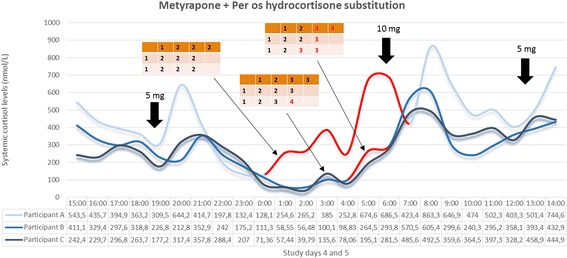Fig. 4.

Systemic 24-hour cortisol profiles of three individuals participating in study stage 1. All participants were under the combined treatment of metyrapone and hydrocortisone per os. The pattern of oral hydrocortisone administration is presented in Table 3, and was identical in all three participants. Metyrapone treatment differed between the three individuals as indicated in the corresponding small tables within the figure; for each small table, each column represents a study day and each row represents the time point within the day in chronological order (during breakfast, lunch and in the evening) to receive metyrapone. The numbers within the small tables’ cells represent the number of metyrapone pills administered (1 pill = 250 mg metyrapone). Circulating cortisol levels in participant A exceeded normal values at all periods of his 24-hour study, while during his sleep period cortisol pulses were present (red part of the curve) which could not be explained by substitution therapy. Thus, adrenal gland suppression was ineffective. For participant B, the evening dose at every study day was transferred from dinner time to just prior to going to sleep for the night, and a number of doses during study days 3, 4 and 5 were increased from 2 to 3 pills, as indicated in red colour in corresponding small table. Circulating cortisol levels in participant B remained under normal values at all periods of his 24-hour study except for the morning peak and some signs of endogenous adrenal activity just prior to awaking (red part of the curve). For participant C, the evening dose of study day 4 was further increased from 3 to 4 pills as indicated in red colour in corresponding small table. Based on the biochemical results of participant C, this last metyrapone treatment scheme was adapted as the ideal one to effectively suppress adrenal gland for the exogenous hydrocortisone administration to reliably define the exogenously derived pattern of circulating cortisol dynamics
